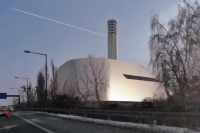District Heating Plant Arsenal,
Vienna
Client: District Heating Vienna AG / Construction Consortium ZAUNER - HABAU
Development Period: 2010 to 2015
On the Arsenal premises in central Vienna, a new district heating plant has been built in the vicinity of the existing plant.
The station comprises basically two boilers with thermal outputs of 170 MW each as well as the associated power control system, pressure reducing stations, oil tanks, pumping stations and a water reservoir.
The project extends over an area of 90 m x 40 m and consistently reaches 10 m below surface.
For this project, BGG Consult has been commissioned by the District Heating Vienna AG with the compilation of the expert's reports "Geotechnics" and "Hydrogeology" for the combined procedure of environmental assessment and building permission.
In order to obtain the necessary basic information, subsoil explorations in form of drillings, dynamic probings and exploratory pits were carried out. The boreholes were developed into ground water gauges or wells to obtain information on the ground water situation. In specific wells, pumping tests were conducted.
During construction, BGG Consult attended to the geotechnical and hydrogeological on behalf of the construction consortium. This included essentially the verification of the building pit protection measures, the approval of the foundation contact areas as well as the definition of the soil exchange measures. Furthermore, the circumferential drainage system has been designed.
Hydrogeological Situation:
Since the structure reaches several meters below the ground water table, the hydrogeological situation had to be carefully examined with regard to the construction pit securing as well as to the environmental impact.
Based on the exploration results, a water-tight pit securing could be avoided. Instead, a shotcrete wall was implemented, which is more economical in comparison to the originally planned jet grouting wall.
Using this method, a reduction of the impact on the environment was possible by placing a gravel filter layer below the structure, which allows for a ground water exchange.
January 2016
